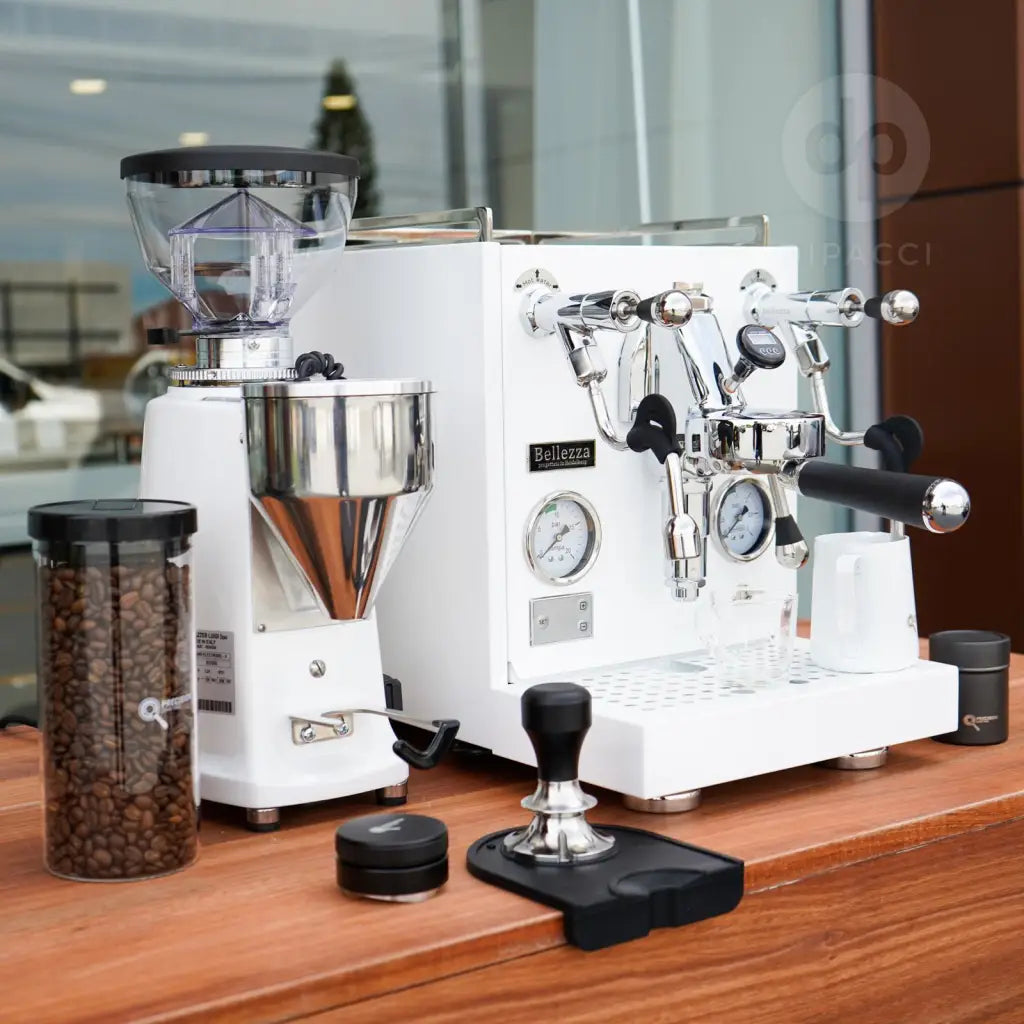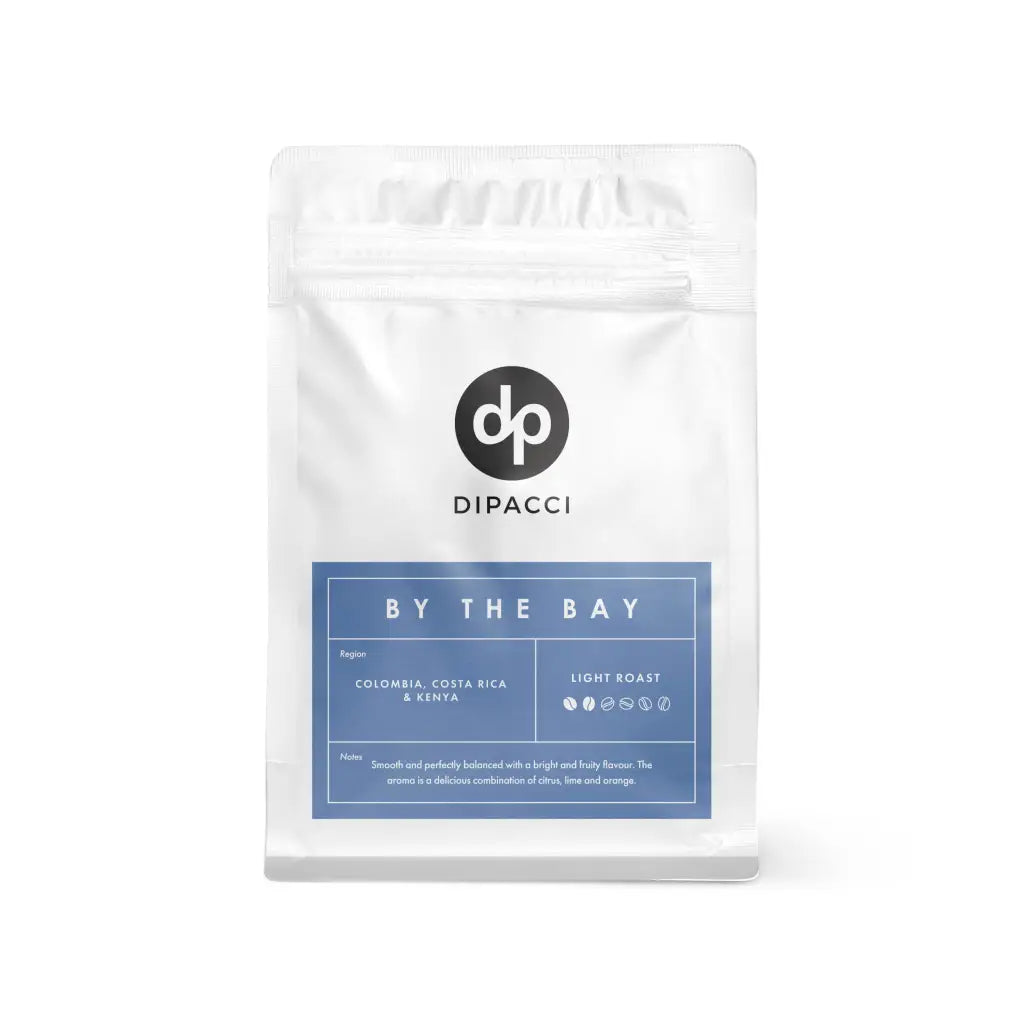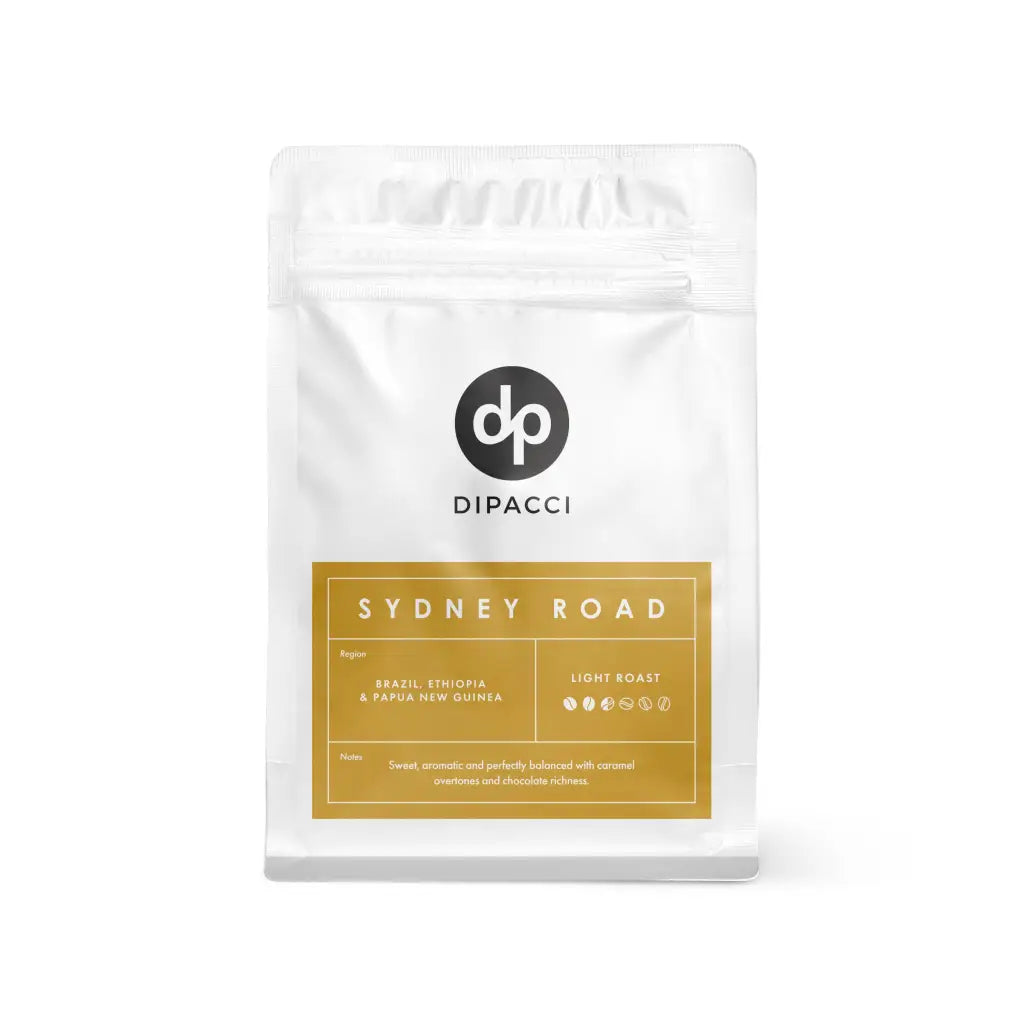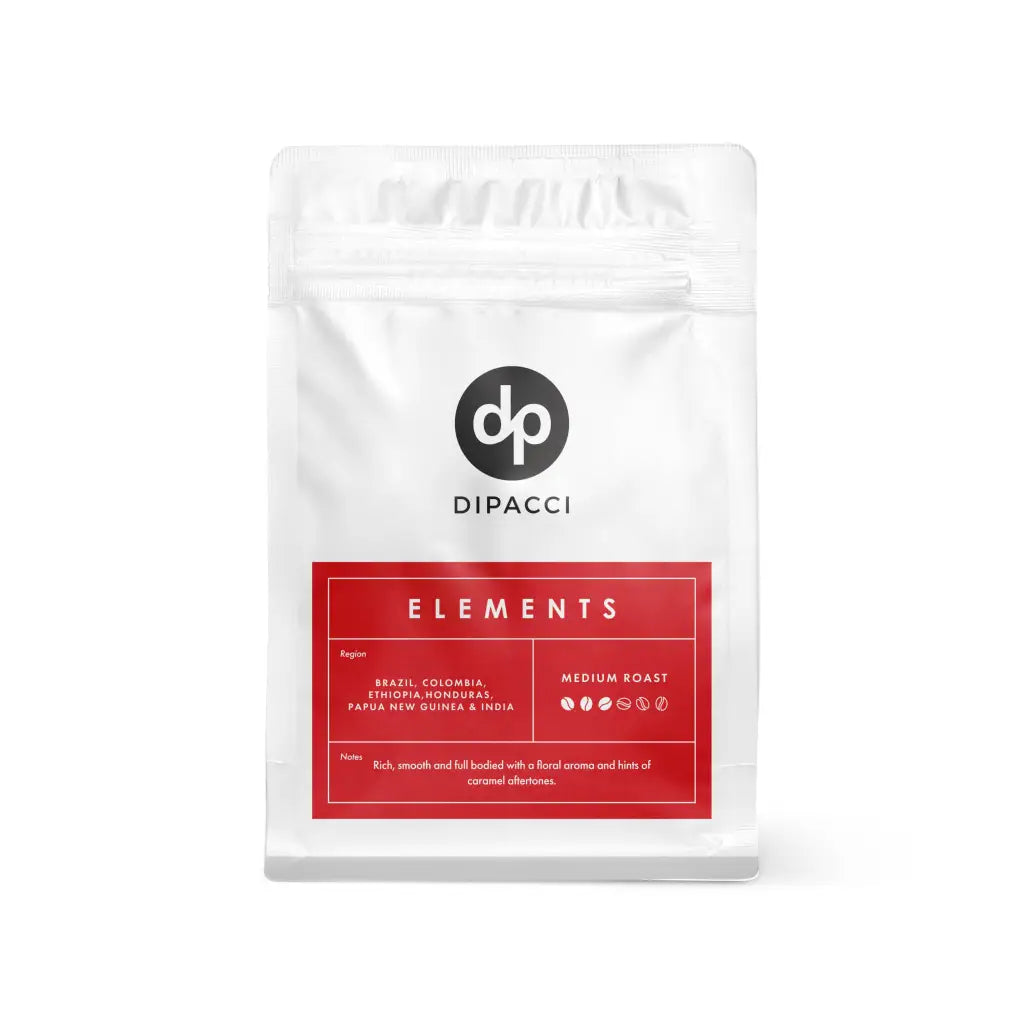Features:
- Construction in stainless steel only, including frame, also the black powder coated parts
- Fully new developed double boiler system in stainless steel
- Completely new designed group in stainless with high neck
- Electronic temperature controllers driving solid state relays on both boilers, PID on coffee boiler, no moving parts
- Steam boiler equipped with a heat-exchanger to pre-heat the water going into the coffee boiler.
- Diffuser in POM plastic, doesn`t get dirty as soon, easy to clean and doesn`t affect the water temperature on its last path towards the coffee. Diffuser is easily removable.
- No screw to hold group screen, yet screen and rubber gasket are easily removable through openings in the bottom plate of the group to reach the sides of the rubber gasket ring
- Self bleeding group
- Group solenoid valve in stainless only
- 0.6mm jet
- Progressive pre infusion cylinder, spring loaded chromed piston shaft actually moves up through body panel during extraction
- External commercial grade rotation pump with motor
- Two different temperatures of hot water available through one switch
- Activation of group by small lever with shift gate: off-infuse-brew
- Strong and long lasting steam power, steam tip with 4 holes
- Filter holders with teflon coating on inside
- Drain tray adjustable in height
Construction:
The Speedster has 2 boilers.
The coffee water boiler is made from 3mm stainless steel tube and 6mm thick flanges. The steam-hot water boiler is done in 2mm stainless tube with 6mm flanges.
There is a large hole on top of the coffee water boiler on which the group is installed. The group is made in 4 and 5mm stainless. The group is welded, also onto the boiler. The welding is done both on the outside as well as the inside to prevent crevices which may cause corrosion. The neck of the boiler is situated vertically to allow for a proper constant thermo-siphon heat flow inside, reaching the full length and height of the group. Both the cover as the bottom of the group are removable, sealed by o-rings.
The entire frame is made from 3mm stainless steel, including the black powder coated parts. Body work is in 1mm stainless, drain tray in 2mm.
Steamboiler
The rear steam boiler has a total capacity of 3.5 litre. An electronic temperature controller gets it information through a very precise and fast reacting probe, located in the steam, and activates the heating element via a solid state relay. The heating element provides a powerful 1.800Watt. This is divided over two elements of 900Watt each, mounted on one flange. There are no moving parts in the heating system.
The steam valve has a large knob, stainless steel wand and a steam tip with 4 holes in fan-shape, each with a diameter of 1,2mm.
Activation of the hot water is done by a switch. The large manual valve on the machine is empty inside, only providing a connection between inner tube and outside wand, visually symmetric to the steam valve.
Two different hot water temperatures can be supplied by one toggle switch.
Inside the machine hot water running from the steam/hot water boiler towards the hot water valve is directed first through a mix manifold. On this manifold 2 solenoid valves are installed, one for hot, one for cold water. The cold water flow is restricted by a 0,6mm jet. Pushing downwards the long lever toggle switch activates both solenoid valves and the pump, resulting in a quiet flow of hot water with a temperature of just below boiling point. When the lever of the toggle switch is pulled upwards, only the hot water solenoid is activated. This results in hot boiling water flowing directly from the boiler to the wand.
Coffeeboiler
The cold water entering the machine is first directed through a heat-exchanger located inside the steam boiler. Exiting the heat-exchanger its temperature is higher than needed. It is cooled down by flow-crossing the outgoing hot water with the incoming cold water and running through an extra long tube outside the boiler before entering the coffee water boiler.
At entering the coffee boiler it first travels through an internal tube over the entire length of the boiler.
The temperature of the coffee water is measured and controlled by a highly sensitive probe connected to a PID (Proportional, Integral, Derative) controller. This controller activates the 900Watt heating element via a solid state relay. There is no moving part in the entire heating and controlling system. This ensures an extremely fast reacting system as well as a very reliable one. The PID functions almost make this controller intelligent. It learns from past behavior and actually responds ahead. This results in an very precise temperature management by short pulse activation of the heating element. The brew water temperature can easily be adapted by just pushing a button at the front of the machine. It is adjustable to 0.1 degrees Celsius.
The group
The group is self-bleeding.
Air can be compressed, water cannot. It is important all air is driven out from the coffee boiler. This is done automatically when the brewing lever is used for the first time after installation.
After going to great length to achieve a perfectly exact stable temperature it is important the water does not lose any of its heat, until it reaches the coffee grounds. When brewing, water never leaves the coffee water boiler/group on its path towards the coffee.
It runs via a tube, starting from directly under the group cover, to the three-way solenoid valve. A 0,6mm jet is installed at the entrance of this tube. We designed and made the base of our solenoid valve especially in stainless steel. Brass would absorb too much heat, stainless steel has a heat transfer capability of approx. ten times less than brass. This base forms one end of the group neck and is in direct contact with the water. From the solenoid valve it is routed through another tube towards the bottom of the group. Both these tubes run virtually horizontal inside the group neck. This path makes for an extra temperature stabilizing effect.
Water running from solenoid to the coffee, will not hit the stainless steel bottom plate. The dispersion plate reaches up through the bottom plate, so the water directly enters the dispersion plate. This plate is made in POM plastic, a fully neutral material regarding transferring heat. Also, fats and oils do not adhere easily to this material, effectively keeping it clean. This plate consists of two pieces offering a nicely divided dispersion, held in place by two screws.
The group screen is hold in place by the surrounding rubber group gasket. To pull out the gasket with screen for controlling, cleaning and replacing, a space is provided right above each bayonet cut out in the filter holder locking ring. In this way you can reach to the top of the group gasket at two opposite sides and pull out the rubber gasket ring together with screen.
The rubber gasket ring sits against the bottom of the group. At the bottom of the group a small outward ridge is machined. This ridge is pushed into the rubber gasket each time the filter holder is locked into the group, as an extra sealing surface. The slight moving up of the gasket ring, because of the flexibility of the rubber, provides a soft comfortable feel for the barista. Full sealing is achieved without having to pull the filter holder firmly.
Both filter holders are coated in Teflon on the inside. This ensures no build up of baked-on oils and fats. No scrubbing is needed, just a quick wipe with a paper or towel. It also helps a bit against the loss of temperature when the coffee runs to the cup.
Infusion
The importance of pre-infusion is generally vastly under-estimated. Properly infusing the grounds makes for and even wetting and swelling of the grounds, preventing channeling. More importantly however, pre-infusion allows a slow warming and softening of the fats and oils in the coffee grounds, before extracting these with high pressure, resulting in a higher yield of solids in the cup. These fats and oils are in fact the actual carriers of the delicate aromas and flavors. Machines with a slight variation in brewing temperature tend to offer a larger spectrum of different flavors from the coffee grounds. On machines offering a very strict temperature a well-executed pre-infusion becomes imperative, otherwise they might not be able to extract the full area of complexities hidden in the coffee.
The Speedster is standard equipped with a threefold infusion system.
-A 0.6mm jet is positioned ahead of the solenoid. As soon as the solenoid is activated the water runs through the empty tube from solenoid to coffee. This allows for a soft start of the extraction process as any pressure will first be lost because all empty spaces (tube, dispersion plate, space between dispersion plate screen) need to be filled. Pressure will only raise after the coffee bed has been fully saturated.
-The brew activating shift-gate lever has three positions: stop-infuse-brew.
The center infuse position opens the solenoid but does not activate the pump.
Water now enters with line pressure only.
The lower position also activates the pump.
These possibilities allow the barista to give the above process the time he/she thinks necessary to fully develop.
Note: as soon as the group solenoid is activated, the filling up system of the steam boiler is automatically disconnected. This prevents any unexpected interruption or sudden loss of pressure during the infusion process.
-The base of the group solenoid has a third tube incorporated. This 4mm tube runs to the progressive pre-infusion cylinder. A piston with spring sit inside this cylinder. As soon as the coffee grounds are fully saturated, the pressure will start to raise.
This first raise in pressure is absorbed by the spring. Because this is a spiral spring its tension will raise as it gets compressed. The more the piston is pushed in, the more difficult it becomes to push it further. This results in a pressure onto the coffee grounds that is at first fully absorbed, then slowly and progressively raised.
The effect is a long, slow and soft infusion. This effect even occurs when the brewing lever is jammed to its lower position right away, solenoid and pump activated at once.
The travel of the piston, and thus the developing infusion, can be checked by the barista, as the rear shaft of the piston moves up through the front body panel.
An additional aspect of the progressive pre-infusion cylinder is some cleaning. After the extraction process is ended, the remaining pressure inside the basket is purged through the internal tube and solenoid, then to the drain.
When this pressure has vanished the spring pushes back the piston. All clean water inside the cylinder is forced through the solenoid towards the drain. This flushes the internals of the solenoids. Of course the tube between solenoid and coffee is not flushed, so back-flushing is still needed once in a while.
Safety
The steam boiler has two probes to monitor the level of the water inside.
The lower probe is located just above the heating element. When the machine is fired and filled for the first time, the brain only switches on both temperature controllers, and thus the heating elements, when the lower probe detects water. During filling up, the coffee boiler is filled much quicker than the steam boiler because the steam boiler fill valve has a restrictive 0.6mm jet installed. This to have cold water enter gently, allowing the heating element more time to keep up the pressure. So when the lower probe in the steam boiler detects water the element inside the coffee boiler is already submerged. This system ensures the elements cannot be turned on while not being cooled by surrounding water. When the higher probe contacts water the brain de-activates the fill solenoid and pump. These are activated as soon as the higher probe does not detect water. This probe has a bent hook. The other end of the probe, inside the boiler, is bent identically. This offers the barista some way to adjust the level by simply turning the probe.
Both electronic temperature controllers have a restricted upper temperature programmed.
When this temperature is reached no more signal to the solid state relay is sent.
Each boiler is equipped with an overheating cut-out switch. This switch is screwed into the boiler flange. When it detects too high a temperature, it will disconnect power to the element.
The steam boiler is equipped with a safety valve.
The coffee boiler system, including the heat-exchanger, is equipped with a expansion valve, factory adjusted at 11-12 bar.
Dimensions:
- Width body 47cm
- Width incl. wands 50cm
- Height body 31cm
- Height incl. valves 37cm
- Depth front feet till rear of body: 53cm
- Total depth incl. free hanging drip tray 65cm
- Width of feet at front 44cm
- Width of feet at rear 18cm
- Depth between feet 37cm
- Depth from rear feet to rear of body 12cm
- Depth from front feet to front of drip tray 13cm
- Diameter feet 2cm
- Shipping crate: 93,6x91,6x48,8(H)cm
- Shipping weight, fully crated: 82kg
- Total wattage 3.100, including pump motor
- Voltage 200-240
- Herz 50-60

















































































































































































